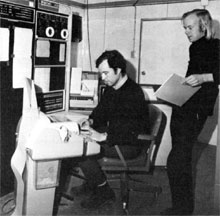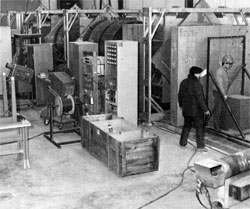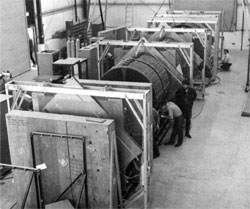Physicists in Experiment No. 26 Find a New Home
Equipment and apparatus for NAL Experiment No. 26 were moved into the Muon Laboratory in the Neutrino Laboratory area during January, 1972. Two main groups of experimenters were involved in setting up the apparatus since July, 1971. They previously worked in the Industrial Building #3 in the Receiving Department, awaiting the completion of the Muon Laboratory.
The group from Michigan State University consisted of K. Wendell Chen, Don Fox, Paul Kunz, Chuen Chang and David Chapman. The collaborating group from Cornell included Lou Hand, Stu Loken, Yasushi Watanabe, and Bruce Meyer. Also Mark Strovink, affiliated with both Cornell and Princeton and Wayne Vernon from the University of California at San Diego participated in this experiment.
Some of these physicists are already familiar faces on site since they have been interacting with NAL staff members frequently during on and off hours for many months. These physicists were interested in using the muon beam which emerged parallel to the neutrino beam. Their aim was to study the electromagnetic structure of the proton by studying muon scattering.
Approved plans for experiments with this bubble chamber are thus described by Dr. Voyvodic: "First, a series of eight 'quickie' experiments with the 'bare' chamber were scheduled, utilizing the full energy range of NAL proton and meson beams, in order to survey the kinds of interactions which can be studied for the first time with these particles."
A group of Argonne scientists who are especially familiar with this chamber conduct the first experiment. Other "quickie" experiments included researchers from NAL, UCLA, Brookhaven National Laboratory, CERN, University of Michigan, University of Rochester, Lawrence Berkeley Laboratory, and University of California at Davis.
"Next," says Dr. Voyvodic, "came a systematic experiment in which the chamber were aided by a hybrid system with wide gap optical spark chambers." Four laboratories-Michigan State University, Iowa State University, University of Maryland and Argonne carried this work out, with additional participation by Duke University, University of Toronto, Purdue University, University of Notre Dame and University of Wisconsin.
And, "additional experiments were conducted by another group of nine laboratories who provided further wire-chamber and computer instrumentation to enhance the hybrid capabilities of this unique bubble chamber installation," according to Dr. Voyvodic.
The successful testing of the chamber in its new surroundings started on November 1, 1971, when the main components began a "cooldown" reaching down to 450 degrees below zero (-450°F). At this temperature, controlled boiling of liquid hydrogen was achieved to produce particle tracks on November 9th.
During the checkout tests of the chamber, the electrical power supply for the powerful magnet in the system arrived from California. This was readied to allow full experimental operation, with the bubble chamber group pausing occasionally to check on progress at the NAL Main Ring. The 100 to 500 BeV beams brought exciting events to this group of scientists in the Bubble Chamber area.





